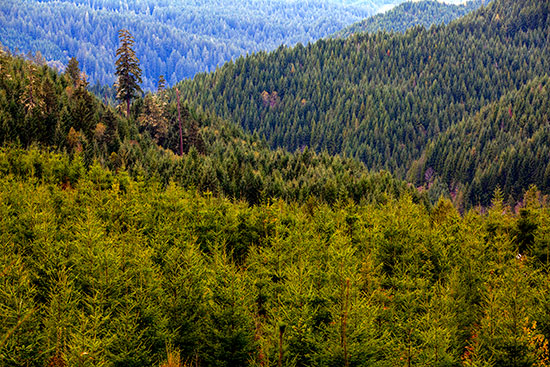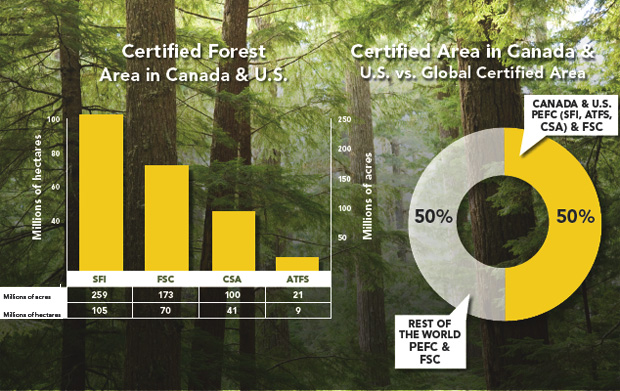The Impact of Wood Use on North American Forests
Learning Objectives:
- Evaluate the use of wood as a construction material in the context of long-term forest sustainability as well as attributes such as low embodied energy and light carbon footprint.
- Discuss forest sustainability measures such as biodiversity, soil and water quality, and harvest vs. net growth.
- Examine the concept that using wood in buildings provides an incentive to landowners to keep forested lands forested instead of converting them to uses such as urban development.
- Compare the carbon benefits of an unmanaged forest vs. a managed forest where timber is used for wood buildings
Credits:
As green building has evolved beyond its initial emphasis on energy efficiency, greater attention has been given to the choice of structural materials and the degree to which they influence a building’s environmental footprint. Increasingly, wood from sustainably managed forests is viewed as a responsible choice—for a number of reasons. Wood grows naturally by harnessing energy from the sun, absorbing carbon dioxide and releasing oxygen. It is renewable and a carbon sink, and outperforms other materials in terms of embodied energy, air and water pollution, and other impact indicators.1
But what about the forest? The benefits above notwithstanding, how can building designers be sure that specifying wood doesn’t negatively impact the North American forest resource?
As this course will demonstrate, the answer to that question has several elements. On one hand, North American forest practices are among the world’s best and the amount of forested land, in both the U.S. and Canada, has been stable for decades. On the other, there are threats—such as climate change, increased wildfire, insect infestation and disease, and deforestation due to urban development—which are broader than the forest industry and must be addressed at a societal level. Drawing from a wide range of research publications, the following pages will examine the current state of North American forests, modern forest practices and criteria for sustainability, and consider some of the challenges that could profoundly impact the future of the forest resource. In this context, the course will also discuss why strong markets for wood products provide an incentive for landowners, not only to invest in forest management, but to keep forested land forested even though greater profit can often be made by converting it to other uses.

Photo: Ian Shive, courtesy of Plum Creek
Regenerating forest, Oregon
Is North America Running Out of Forests?
“On the whole, no evidence suggests that we are using up our forests. In fact, the total area of forests has been stable, and the volume of wood on them increasing.” — National Report on Sustainable Forests – 20102
Until the early 1900s, settlers coming to North America cleared an average of 2.1 acres of forest per person to survive and grow food.3 Since then, the establishment of industrial agriculture and other changes in land use have mitigated the need for forest clearing and forest acreage has been stable for close to a century.
The U.S. reported an annual increase in forest area of 0.12 percent in the 1990s and 0.05 percent from 2000 to 2005, while Canada reported no change.4 In both countries, responsible forest management has resulted in more than 50 consecutive years of net forest growth that exceeds annual forest harvests.
United States
According to the National Report on Sustainable Forests – 2010, the U.S. has approximately 751 million acres of forest area, which is about one third of the country’s total land area. “This stability is in spite of a nearly three-fold increase in population over the same period and is in marked contrast with many countries where wide-scale deforestation remains a pressing concern.”
Forty-four percent of U.S. forests are owned by entities such as national, state and local governments; the rest are owned by private landowners, including more than 22 million family forest owners. The fact that net forest growth has outpaced the amount of wood harvested for decades supports the idea that landowners who depend economically on the resource have a strong incentive for their sustainable management. This aligns with global forest data, which indicates that forest products and industrial roundwood demands provide the revenue and policy incentives to support sustainable forest management.6 However, with urban development and other uses increasingly vying for land, an issue going forward will be making sure that landowners continue to have reasons to keep forested lands forested.
Canada
Canada has 860 million acres of forestland,7 which is about 90 percent of the forested area it had before European settlement.8 Ninety-four percent of the forest is publicly owned and managed by provincial, federal and territorial governments. The remaining 6 percent is on private property belonging to more than 450,000 private landowners.
Wood supply is the term used to describe the estimated volume of timber that can be harvested from an area while meeting environmental, economic and social objectives. Governments regulate harvest levels on public lands by specifying an annual allowable cut.

Photo: Frank Rosenstein, courtesy of Plum Creek; Forest certification credit: www.sfiprogram.org, www.pefc.org, www.fsc.org, www.forestfoundation.org
Second growth working forest, Oregon











